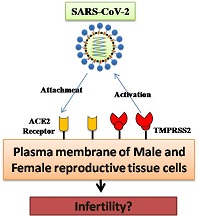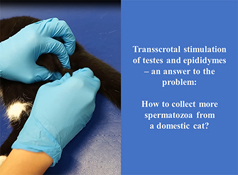Reproduction, Fertility and Development
Volume 33
Number 6 2021
This review is a systematic compilation of recent reports regarding molecular cross-talk between severe acute respiratory syndrome coronavirus-2 (SARS-CoV-2) causing COVID-19 and angiotensin-converting enzyme 2 receptors on cells, addressing major issues with both male and female reproduction at the cellular and subcellular levels. We also emphasise the physiological aspect of gender biases, interrogating why the male population is affected more than females by COVID-19. These issues should be considered by the scientific fraternity as an important future strategy to prevent another episode of SARS-CoV-2 infection.
Species of wild rodents such as Spix’s cavy may be an alternative model for studies related to disorders of genital development in humans. The production of sex hormones by fetuses played an important role in masculinization and sexual differentiation of male fetuses. Expanding such studies to other rodents, and other mammalian species, will likely shed light on the general importance of such observations.
Spermatid perinuclear RNA-binding protein (STRBP) binds many RNAs and loss of STRBP impairs male fertility. However, the function of STRBP-interacting long non-coding (lnc) RNAs remains unknown. In this study, the roles of the STRBP-interacting lncRNA predicted gene 31453 (Gm31453) and its potential target gene encoding carboxypeptidase A5 (Cpa5) in spermatogenesis were determined. Deletion of Gm31453 disturbed expression of both its target and interacting gene, as indicated by decreased Cpa5 and increased Strbp mRNA levels. Interestingly, both Gm31453- and Cpa5-KO mice showed normal spermatogenesis and fertility.
Early pregnancy failure (Day 15) in the mare remains a significant source of economic loss to the equine breeding industry. Ironically, there is little information regarding this period in the mare, and the unique morphological and physiological features of the equine conceptus limit the extrapolation of information from other domestic species. In this study, we demonstrate that, soon after the embryo enters the uterus, it exerts a stage-dependant local regulation that is accomplished through different simultaneous and balanced mechanisms, encompassing the requirements of equine early pregnancy.
The reason for the higher incidence of infertility/subfertility in crossbreed compared with purebred bulls is not known. This study established the metabolomic profile of zebu and crossbreed bull spermatozoa and identified metabolomic changes in crossbreed bull spermatozoa. The study shows that aberrations in taurine, hypotaurine and glycerophospholipid metabolism may be associated with the higher incidence of infertility/subfertility in crossbreed bulls.
Semen preservation could help feline breeding and wildlife conservation, but is limited in felids due to problems with semen collection. Manual stimulation of the scrotum can improve urethral sperm collection in domestic cats, allowing a higher number of spermatozoa, of better motility and morphology, to be obtained. Improvements in the collection of spermatozoa from cats may contribute to the wider use of artificial reproductive techniques (e.g. semen preservation and further shipment worldwide) in veterinary practice.
 , Vikash Chandra, Pratheesh Mankuzhy
, Vikash Chandra, Pratheesh Mankuzhy  , Yasotha Thirupathi, Dilip Kumar Swain, Harikrishna Pillai, Shailesh Kumar Patel, Mamta Pathak and SaiKumar Guttula
, Yasotha Thirupathi, Dilip Kumar Swain, Harikrishna Pillai, Shailesh Kumar Patel, Mamta Pathak and SaiKumar Guttula










